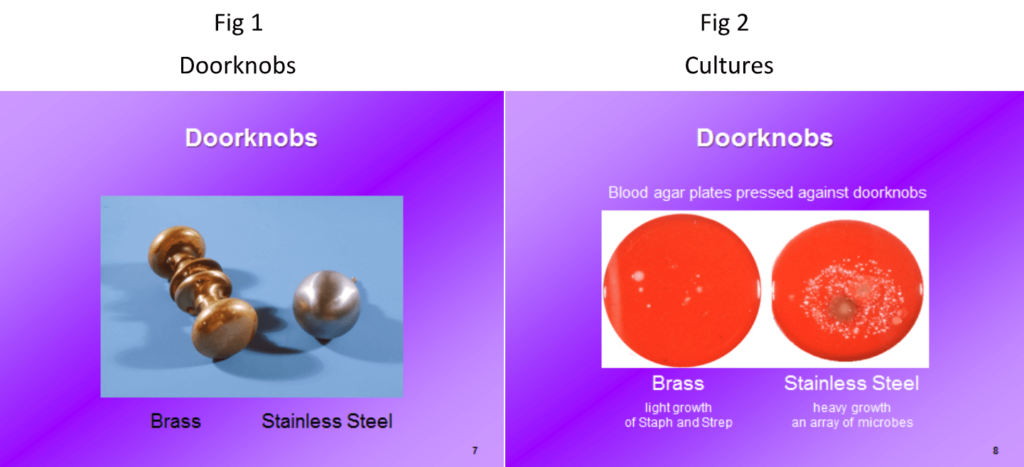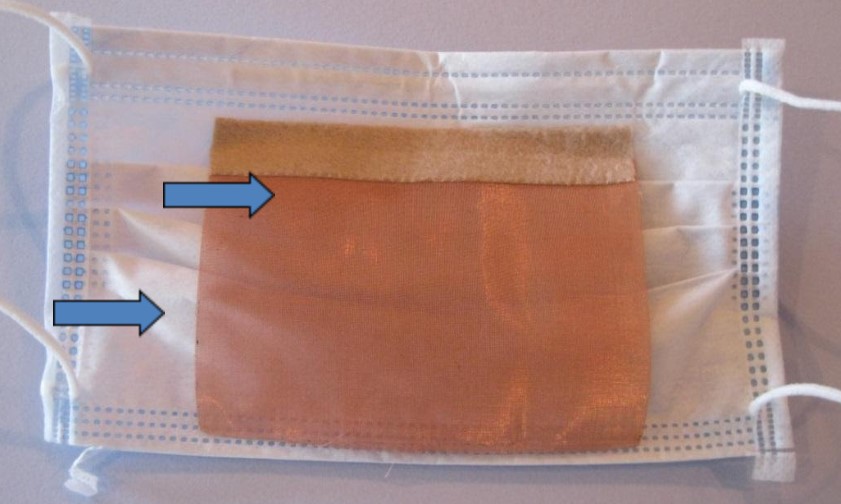I. History
Need: My personal interest in copper evolved from my early work at Hamot Medical Center, Erie, PA in Microbiology and Infection Control. In 1983, a student’s research project on doorknobs showed that brass had very light growth of a small array of microbes and stainless steel, a large heavy growth and large array. (Fig 1, 2) Further research disclosed brass disinfected itself within a few hours, whereas microbes on stainless steel remained viable for months. Copper, a cidal (killing) component of brass, disinfected itself within a few minutes. Subsequently, hundreds of articles have been published describing this cidal activity.
Kuhn P. Doorknobs: A Source of Nosocomial Infection? Diagnostic Medicine 6(8):62-63, November/December 1983. This article was the first to recognize a copper alloy (brass) application in Infection Control and was distributed world-wide by the Copper Development Association.

With extensive microbiology, medical research and some product development experience, I have always had a desire to create a copper mesh mask. I frequently caught a cold, about 50% of the time, while flying. Several friends and colleagues reported similar experiences after flying. I thought if I developed this product, it could potentially help me and perhaps help others. Several of my friends and colleagues who have since used the mask reported positive experiences.
“Since I began using the mask and have been on several flights, I have had almost no colds. Once, I did catch a cold and used the mask. My cold resolved in 2.5 days, instead of the usual 2 to 3 weeks.” (See User Comments)

Fig 3 – https://unsplash.com/photos/tTfDMaRq-FE
Airline Travelers in crowded conditions often breathe poor quality air
CDC reported respiratory infections represented the leading cause of returning travelers to seek medical attention. (1) Airline travelers are at increased risk of contracting respiratory infections. Poor air quality, crowding, and other factors are a few of contributing causes. (Fig 3) The most common causative agents include rhinoviruses, respiratory syncytial virus, influenza virus, parainfluenza virus, human metapneumovirus, measles, mumps, adenovirus, and coronaviruses. (2) Copper is known to kill flu and other respiratory viruses including corona virus and bacteria on contact. (3)
- https://wwwnc.cdc.gov/travel/yellowbook/2018/the-pre-travel-consultation/respiratory-infections
- Zitter,J. Upper Respiratory Tract Infections Among Airline Passengers. JAMA. 2002;288(23):2972. doi:10.1001/jama.288.23.2972-JLT1218-4-1
- Warnes S, Zoë R, Little C, Keevil W.Human Coronavirus 229E Remains Infectious on Common Touch SurfaceMaterials Rita Colwell, Editor mBio. 2015 Nov-Dec; 6(6): e01697-15. Published online 2015 Nov 10. doi: 10.1128/mBio.01697-15
In 2012, because of personal health issue and after several visits to Moffitt Cancer Center, I realized a copper product could also be of particular benefit to immunosuppressed patients who have to visit crowded doctors’ offices. Since then, many other applications have developed.
II . Product Overview:
A. The Kuhn all Copper Mask and Kuhn all Copper Insert are made of 99.95% pure copper mesh that sanitizes and filters the air. (Fig 4, 5) The Masks are reusable by single wearer. They can be disinfected with 70% isopropyl alcohol or sterilized by autoclaving. If sterilized, others may wear them. The copper mesh has a 30% open weave, ensuring a comfortable wearing experience and easy breathing, without becoming too warm or fogging glasses. This allows a minuscule amount (2 ppm in highest sample) of copper to be deposited in the nose.
Published reports of laboratory studies confirm the copper is known to kill coronavirus, flu, and other respiratory viruses and bacteria on contact. Copper is a known anti-inflammatory agent, as well. Currently, no clinical trials are available on the use of the Kuhn All Copper Mask or Copper Mesh Insert with corona or other viruses, nor on its use as an anti-inflammatory agent. No data are available on extended wearing times.


Copper weave: 1 sq inch equivalent to 2.8 sq inches of flat surface

The copper mesh weave produces a large surface area and allows impingement Cu atoms in the nose (est 1.6 ppm after three hrs of wear). (Fig 6 A, B)
Despite the flow of air, the mesh is water-resistant. This is important if a person is exposed to a sneeze. (Fig 7) as the mesh can repel the droplets. (Fig 8)
https://en.wikipedia.org/wiki/Sneeze

Recommended Uses: When breathing sanitized and filtered air is important.
- Exposure to a potentially infectious person
- Respiratory Infections
- Environmental Allergies
- Red Tide
B . The Copper Mesh Insert (Fig 10) The Copper Mesh Insert (CMI) is a pure copper mesh insert (4” x 3”) designed to be worn beneath a mask for an extra layer of protection. The CMI adheres to the mask via a mole skin tape, thus adding a sanitizing element to the mask and augmenting its protective properties.
Recommended Uses: When breathing sanitized and filtered air is important.
- Exposure to a potentially infectious person
- Respiratory Infections
- Environmental Allergies
- Red Tide
See Insert Instructions for full descriptions of uses.

Top arrow: Copper Insert (4” x 3”)
Bottom arrow: Conventional Mask
III . Product Differentiation



IV . Milestones
- Patents
- Utility Patents Pending:
- Use of Copper Mesh for Masks
- US and Europe International Patent Cooperation Treaty (PCT)
- Use of Copper Mesh for Masks
- Utility Patents Cleared:
- Canada
- Design Patent Allowed:
- Mini-mask
- Canada, China, Japan, Europe, US
- Pending: South Korea
- Mini-mask
- Provisional Patents:
- Copper Insert for use beneath a standard mask
- Provisional use of KCM for mitigating respiratory effects of toxic algal blooms and cyanobacteria
- Utility Patents Pending:
- Prototypes Developed
- Company Established. 2017 Kuhn Copper Solutions LLC. board established
- Small Manufacturer Contracted (Quest, a sheltered workshop in Orlando, FL)
Several preliminary lab studies completed. FDA reports with detailed descriptions of tests available on request.
- Cidal activity of mask demonstrated., 90% kill of microbes within 5 minutes of contact.
- Immediate disinfection with isopropyl alcohol demonstrated.
- Proved cidal activity at two years (aged copper mesh) to support outdate
- Proved of cidal activity 50+ years copper penny study
- Proved Cu impingement (2 ppm) Cu in NP area (ICPMS)
- Proved minuscule amount (1ppm) of Cu eluted after 72 hrs at 37C
(Levels of copper on skin and in np area several logs lower than the amount of Cu known to cause adverse effects.) - Fluid penetration study*
- Particulate filtration efficiency*
- Differential pressure*
- Bacterial filtration *
- Flammability
- Extensive literature research completed on cytotoxicity, sensitivity, irritation, and biocompatibility. Product is safe and effective when worn as directed.
*NOTE: Cu mesh will fail blood penetration test, differential pressure test, particulate test, and bacterial filtration test for surgical masks. This is not a surgical mask. The mechanism of action relies on low differential pressure and good airflow so that Cu will impinge in NP area and act as a cidal and anti- inflammatory agent. Of note: Kuhn Copper Mesh Mask can be worn beneath a standard mask. For greater comfort, a copper mesh insert can be adhered to a standard mask, providing an added barrier in high risk situations.


